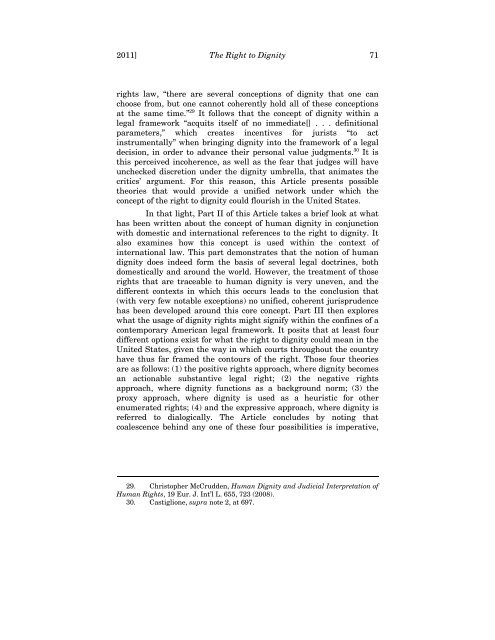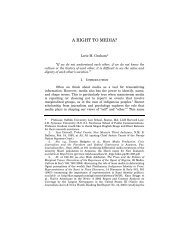The Right to Dignity Rex D. Glensy - Columbia Law School
The Right to Dignity Rex D. Glensy - Columbia Law School
The Right to Dignity Rex D. Glensy - Columbia Law School
Create successful ePaper yourself
Turn your PDF publications into a flip-book with our unique Google optimized e-Paper software.
2011] <strong>The</strong> <strong>Right</strong> <strong>to</strong> <strong>Dignity</strong> 71<br />
rights law, “there are several conceptions of dignity that one can<br />
choose from, but one cannot coherently hold all of these conceptions<br />
at the same time.” 29 It follows that the concept of dignity within a<br />
legal framework “acquits itself of no immediate[] . . . definitional<br />
parameters,” which creates incentives for jurists “<strong>to</strong> act<br />
instrumentally” when bringing dignity in<strong>to</strong> the framework of a legal<br />
decision, in order <strong>to</strong> advance their personal value judgments. 30 It is<br />
this perceived incoherence, as well as the fear that judges will have<br />
unchecked discretion under the dignity umbrella, that animates the<br />
critics’ argument. For this reason, this Article presents possible<br />
theories that would provide a unified network under which the<br />
concept of the right <strong>to</strong> dignity could flourish in the United States.<br />
In that light, Part II of this Article takes a brief look at what<br />
has been written about the concept of human dignity in conjunction<br />
with domestic and international references <strong>to</strong> the right <strong>to</strong> dignity. It<br />
also examines how this concept is used within the context of<br />
international law. This part demonstrates that the notion of human<br />
dignity does indeed form the basis of several legal doctrines, both<br />
domestically and around the world. However, the treatment of those<br />
rights that are traceable <strong>to</strong> human dignity is very uneven, and the<br />
different contexts in which this occurs leads <strong>to</strong> the conclusion that<br />
(with very few notable exceptions) no unified, coherent jurisprudence<br />
has been developed around this core concept. Part III then explores<br />
what the usage of dignity rights might signify within the confines of a<br />
contemporary American legal framework. It posits that at least four<br />
different options exist for what the right <strong>to</strong> dignity could mean in the<br />
United States, given the way in which courts throughout the country<br />
have thus far framed the con<strong>to</strong>urs of the right. Those four theories<br />
are as follows: (1) the positive rights approach, where dignity becomes<br />
an actionable substantive legal right; (2) the negative rights<br />
approach, where dignity functions as a background norm; (3) the<br />
proxy approach, where dignity is used as a heuristic for other<br />
enumerated rights; (4) and the expressive approach, where dignity is<br />
referred <strong>to</strong> dialogically. <strong>The</strong> Article concludes by noting that<br />
coalescence behind any one of these four possibilities is imperative,<br />
29. Chris<strong>to</strong>pher McCrudden, Human <strong>Dignity</strong> and Judicial Interpretation of<br />
Human <strong>Right</strong>s, 19 Eur. J. Int’l L. 655, 723 (2008).<br />
30. Castiglione, supra note 2, at 697.















